Success of Pozega-Slavonia County Proof that Planned Tourism Works
March 25, 2023 - Last year, a record increase in the number of overnight stays was recorded in the Pozega-Slavonia county, and the growth trend continues this year as well. New tourist apartments are being opened, and hotels built.
As Poslovni writes, the Pozega-Slavonia County is a hit among domestic and foreign guests, as confirmed by the excellent tourism results for last year. The county recorded the largest increase in the number of overnight stays, by more than 40 percent compared to the reference, in all of Croatia record 2019.
Most importantly, tourist numbers in Pozega-Slavonia County have been continuously growing. The county has for the past six years recorded double-digit growth every year, and it was chosen to host the recently held coordination of the Croatian Tourist Board with county tourist boards.
Kutjevo, the most famous wine town in Croatia, was chosen for the largest meeting of the system of tourist boards - attended by the Minister of Tourism Nikolina Brnjac, the director of the Croatian Tourist Board Kristjan Staničić, the prefect of the Pozega-Slavonia County Antonija Jozić, as well as the director of the Pozega-Slavonia County Tourist Board Maja Jakobović.
Hotels and villas are opening, the tourist offer is expanding
The great interest of tourists in the Golden Slavonia destination, which covers the entire area of Pozega-Slavonia County, has influenced investors, so some of the largest investments in tourism in the continental part of Croatia are taking place right here. For example, the construction of the Shhhuma hotel in Velika, the spa heart of Slavonia, is expected soon, and the first diffused hotel in this area, Zlatni Lug, will open in the picturesque suburbs of Pozega. Among the valuable investments are the tourist villas in Lipik, the luxurious mountain village Zvečevo na Papuk with a respectable number of villas of the highest category, the recently opened Bećarca Museum in Pleternica...
In parallel with the increase in the number of overnight stays, the number and quality of the accommodation offer is also increasing, having doubled in the last six years. Despite the fact that new accommodation facilities keep popping up, demand has continuously been higher than supply throughout Slavonia.
"Although tourism is not the primary economic goal of these regions, but an excellent addition to the quality offer, the expansion of tourist traffic will continue this year as well. In the strategic development of the destination based on the guidelines of the Sustainable Tourism Strategy of the Republic of Croatia until 2030, which focuses on green transformation and quality, we are continuing with last year's successful projects, but also launching new ones," points out Maja Jakobović, director of Pozega-Slavonia County Tourist Board.
Last year, the County Tourist Board presented an original shift in eno-gastronomy through the direct improvement of the destination's quality with the Zlatna Slavonija Eno&Gastro project, which tourism experts described as an excellent example of how to strategically develop a destination.
"And in 2023, we will continue with new challenges in the eno-gastro offer and we will not stop only at the food and drink offer. Among our new projects is the Zlatna Slavonija Outdoor, which will highlight and promote all the activities that this "hilly" part of Slavonia offers. The destination brand Zlatna Slavonija will be present through all the activities this year, and we will tie our slogan to all the sub-brands in order to complete the story", says the director of Pozega-Slavonia County Tourist Board, inviting travel lovers to explore and experience the natural beauty, cultural sights and the ultimate wine and gourmet experience of Golden Slavonia.
This Slavonian county is confirmation that systematic, multi-year and quality-oriented work definitely produces results.
For more, make sure to check out our dedicated Travel section.
Požega-Slavonia County Tourist Board Wants You to Experience Golden Slavonia
October 9, 2021 - The most beautiful of Golden Slavonia - grapes, vineyards, fields, golden grains, green Papuk, five mountains, five cities, and five municipalities are the inspiration for the Požega-Slavonia County Tourist Board's new marketing concept.
In addition to the new logo, there are new slogans, key messages, websites, promotional films, and targeted marketing campaigns to attract travelers to discover this area, reports HRTurizam.
Wines in three vineyards, the world-famous Graševina, Kutjevo cellar from 1232 - the oldest in this part of Europe and more than 30 wineries in the entire county are an attractive story for wine lovers.
Pleternica with Becarac Square and the Terra Panonica Interpretation Center, Požega with its baroque center, Lipik with the State Lipizzaner Stable and the famous Spa, Pakrac with the Jankovic manor complex, Velika with the Pannonian Sea House, eco-camp, adrenaline park and aqua park, accommodation on tourist farms or in villas on the slopes of Papuk can be seen in the new promotional film Experience Golden Slavonia, which will be shown at the most famous tourist film festivals.
"We have gathered an excellent team that conveyed our key messages in the best way. Our goal is to continue with interactive and multimedia campaigns that attract young modern travelers eager for new experiences. We have a wonderfully warm story, and we could hardly wait to tell it in a new and modern way. So we invite you to embark on the discovery of the Golden Glory; you will not regret it," said Maja Jakobović, director of the Požega-Slavonia County Tourist Board.
The new visual identity is led by Digital Cultural Transformation, and the author of the promotional film is the creative Balduči film team.
Požega-Slavonia County is a small continental destination with highly significant changes. Last year, they quickly adapted to the new coronavirus conditions. An innovative marketing campaign emphasized the attractive natural potential, camps as a recommended type of vacation, and outdoor activities.
“At the beginning of this year, we created a new modern concept from which the new logo, key messages, film, and slogan Golden Slavonia logically emerged. As a result of these activities, we are the only county in the continental part of Croatia that has all the tourist indicators better than in the first nine months of 2018, the year preceding the record tourist 2019," points out Maja Jakobović.
For more on travel in Croatia, follow TCN's dedicated page.
Pozega-Slavonia Hunters Send Two Tons of Game to Earthquake Area
February 2, 2021 – In an admirably understated manner, Pozega-Slavonia hunters humbly pitched in to the relief efforts and sent two tons of game to those in the earthquake-affected area of Sisak-Moslavina
It's fair to say that in this day and age, hunters often get a bad rep. There are far more people in the world today who abstain from eating any meat – vegetarians and vegans – than those who go hunting. Changing times. For sure, it wasn't always this way.
In Croatia, hunting associations play a vital role in maintaining the beauty and accessibility of the country's rural landscape. Not that you much hear about this aspect of their undertakings. Perhaps they are typically just rather understated people?
You might easily come to that conclusion when considering the recent humanitarian action undertaken by Pozega-Slavonia hunters. Organised by the county hunting association and county officials, Pozega-Slavonia hunters from each of the region's district societies contributed in an effort to send the game taken by each – mostly deer and wild boar - to the earthquake-hit areas in Sisak-Moslavina County. They so far managed to send a whole two tons!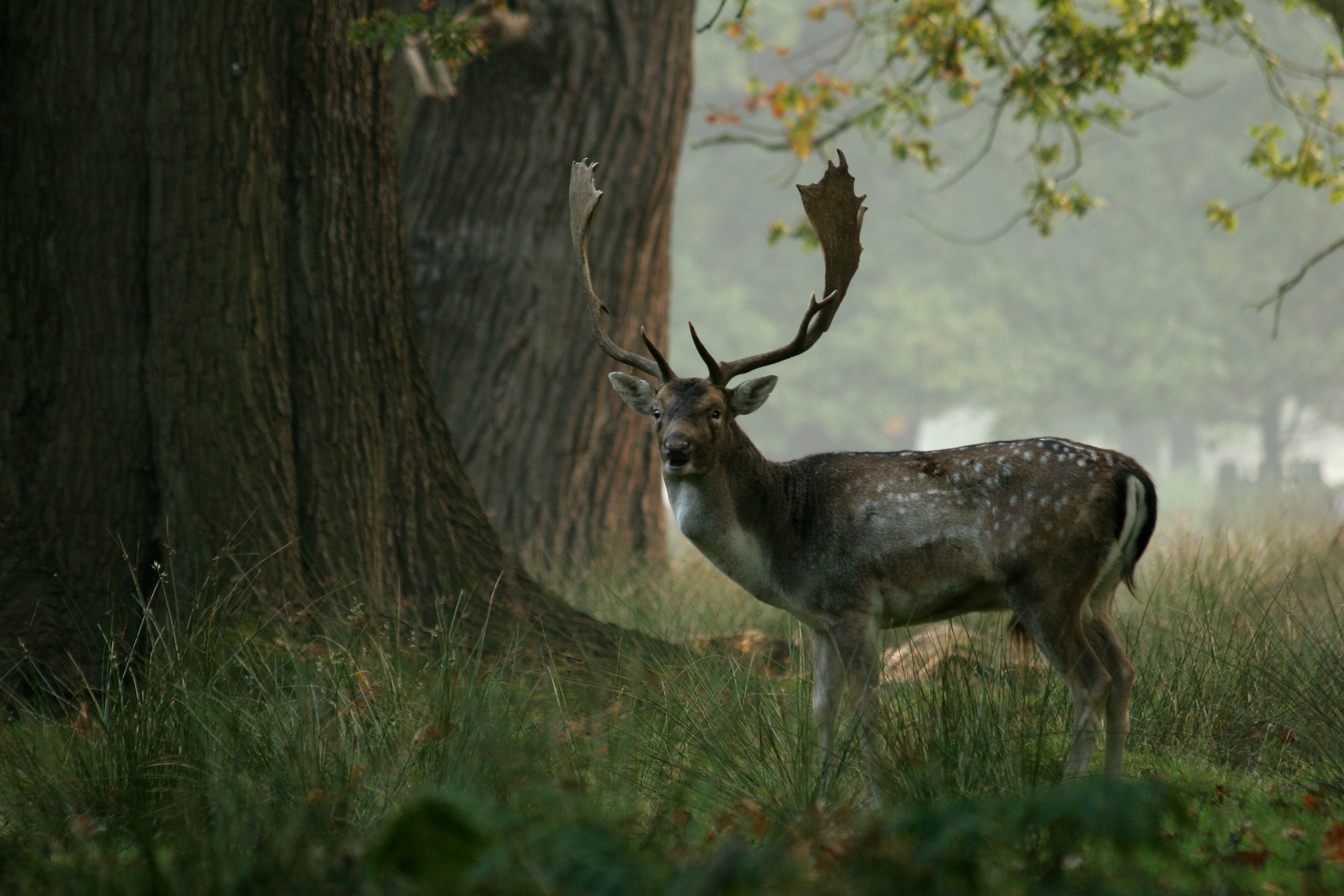
At the same time, Pozega-Slavonia hunters from the county association began collecting funds for the families of those tragically killed in the 29 December earthquake. They have so far collected some 50,000 kunas that will be directed to the intended recipients through the Croatian Hunting Association.
“This is a small help, but undertaken with an open heart,” said a representative from the County, who jointly organised the effort.
“We go to visit friends,” he said, in reference to the delivery of the Pozega-Slavonia hunters game, “and a Slavonian does not go empty-handed. We have loaded more than a ton of meat here (in this shipment), but there will be more because in co-operation with Croatian Forestry, Brod-Posavina County and the Radinje hunting ground, today we will take (in total) about three to four tons of game.”
“(Perhaps) the people of Moslavina will remember Slavonia next time they eat Slavonian čobanac (a local specialty stew, made from game) because she (Slavonia) is always thinking of her (Moslavina),” he concluded.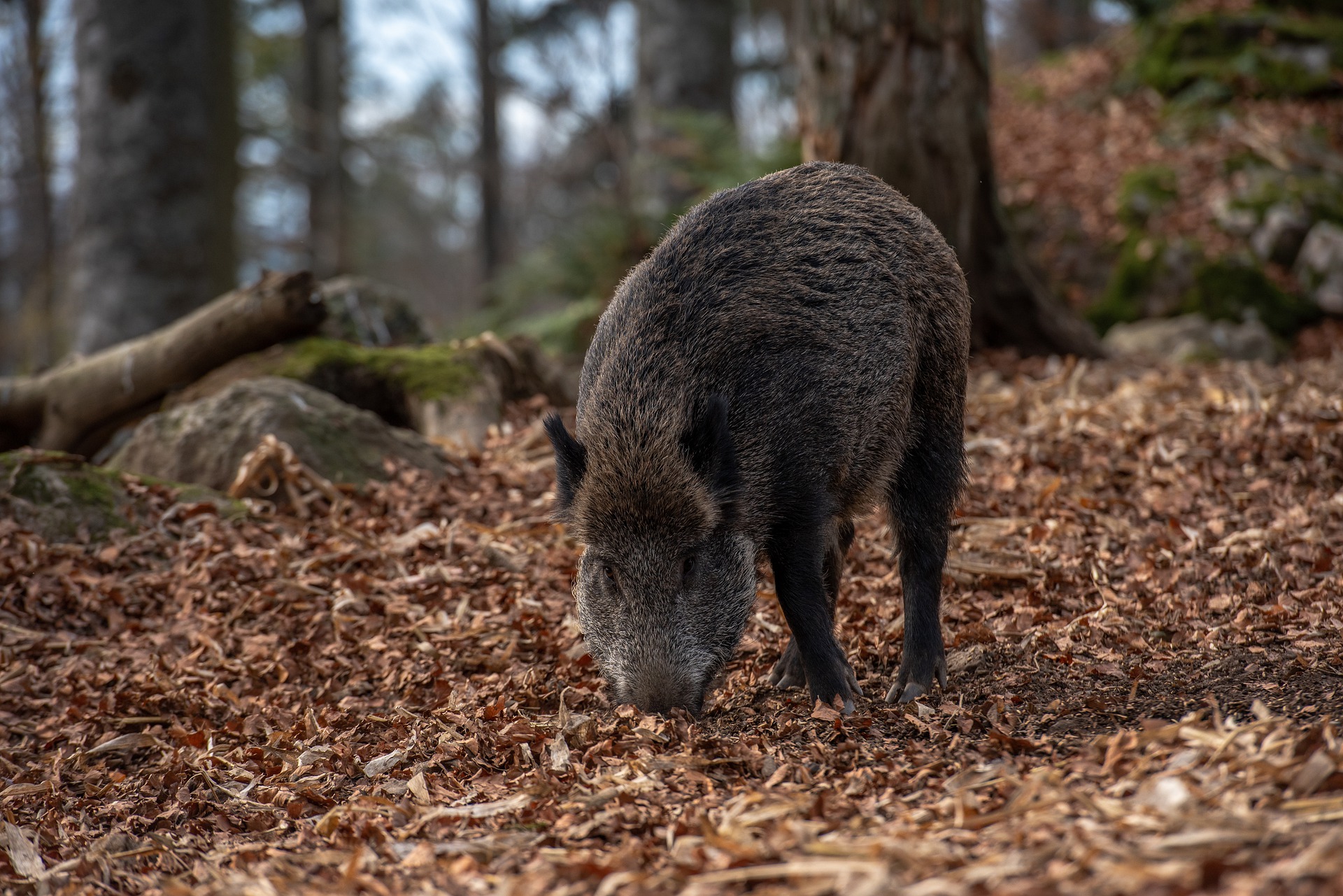
“Lovački savez Požeško – slavonske županije (Hunting alliance of Pozega Slavonia County) was the main organiser,” Mateja Tomasevic, Head of the County office told TCN. “Within it, there are 28 separate societies of Pozega-Slavonia hunters. They all participated in the humanitarian action.”
Among the 28 contributing societies were Hunting Associations 'Fazan' and 'Košuta' from Pakrac, 'Psunj' from Orljavac, 'Šljuka' from Brestovac, 'Jelen', 'Šijak', 'Sokolovac' and 'Sveti Hubert' from Požega, 'Dilj' from Buk, 'Vidra' from Sapna, Čaglin, 'Slavonac' from Kutjevo, 'Strijela' from Bektež, 'Papuk' from Biškupci, 'Sokol' from Bučje, 'Seljak' from Jakšić, 'Vepar' from Kaptol, 'Krndija' from Našice, 'Vranovac' from Vetovo, 'Šljuka' from Pleternica, 'Fazan' from Ruševo, 'Vražjak' from Sesvete, 'Sjeverni Dilj' from Seoce, 'Slavuj Gaj' from Poljana and 'Kuna' from Paka. Over 1300 residents of the county belong to one of the Pozega-Slavonia hunters associations.
Bravo!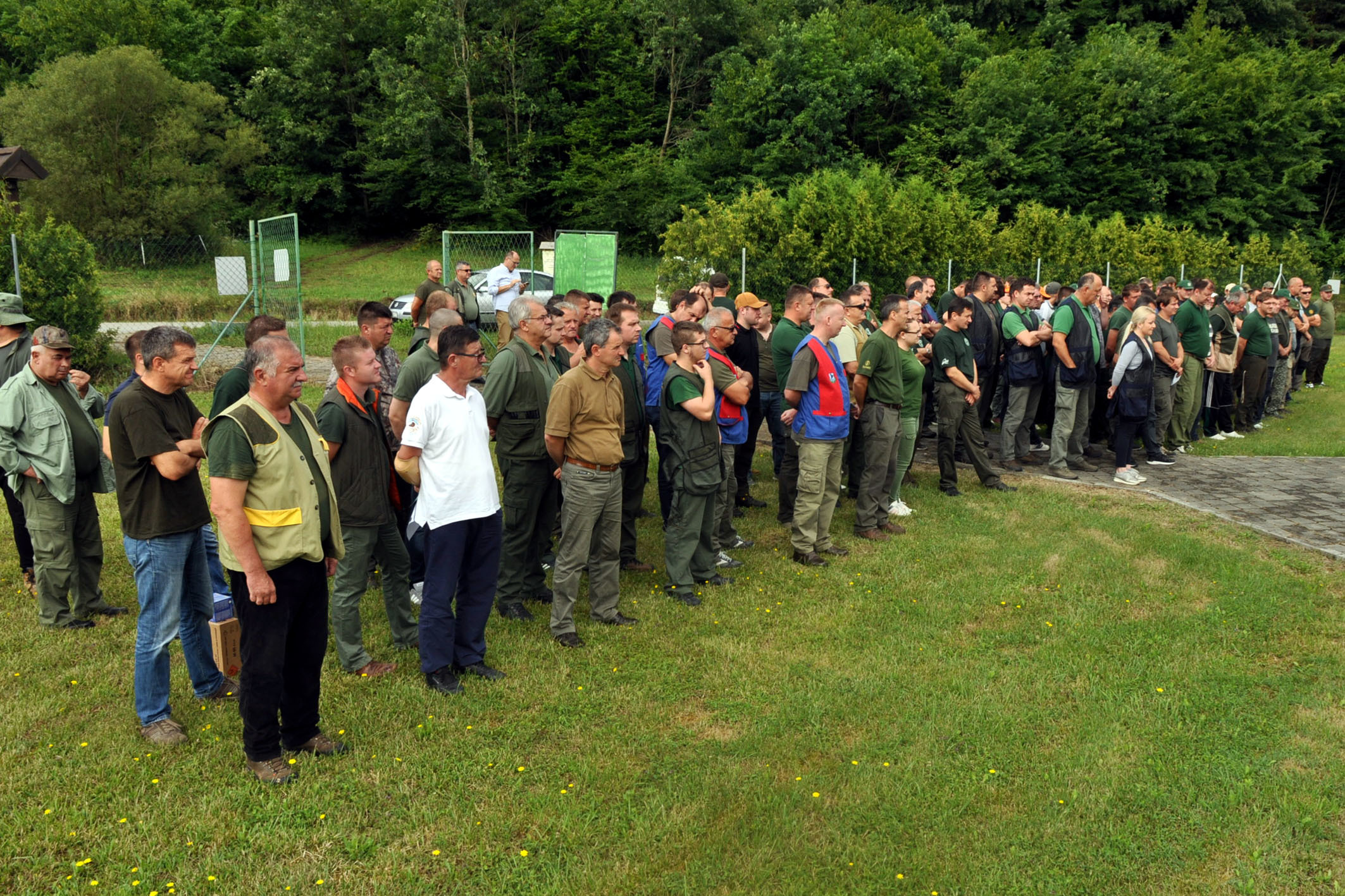 Some of the members of the Hunting Associations of Pozega-Slavonia County © Hrvatski Lovački Savez
Some of the members of the Hunting Associations of Pozega-Slavonia County © Hrvatski Lovački Savez
For the latest travel info, bookmark our main travel info article, which is updated daily.
Read the Croatian Travel Update in your language - now available in 24 languages
Join the Total Croatia Travel INFO Viber community.
Museum of Becarac, Pleternica, Celebrates Slavonia Folk Song
November 7, 2020 – Protected by UNESCO, the unmistakable Slavonian folk song style will get deserved attention at the new Museum of Becarac in Pleternica.
There are lots of pretty little towns in Slavonia like Pleternica. The average outsider often has no way of distinguishing between them. But, Pleternica is determined to stand out. In a smart and considered move, they've decided to become synonymous with a UNESCO-protected element of Slavonian and Croatian culture - Bećarac.
Last year, Bećarac Square was opened in Pleternica. Soon, the town will become home to another symbol of heritage preservation – the Museum of Becarac. The Museum of Becarac will be located right next to Bećarac Square in the center of the town.
Bećarac is a traditional and humorous type of folk song originally from Slavonia. It has an unmistakable sound. It is characterised by a rhyming, call-and-response type of delivery and is performed acapella or accompanied by the traditional Slavonian folk music style of tamburitza. The melody of Bećaraci remains constant, only the song words differ as it continues or is again performed. In this way, Bećarac is more akin to the traditional storytelling aspect of folk music than it is an individual song.
The first verse is sung by the choir leader and forms a logical thesis; it is repeated by the choir of gathered men. The second verse is a humorous antithesis, also repeated by the choir (but often broken by laughter). Bećarci is usually performed at the peak of a party as a drinking song after the crowd is sufficiently warmed up by wine and music. A series of bećarci can last indefinitely. Their words are often made up spontaneously. The creator of the lines of lyrics can draw on many different sources of inspiration - recent happenings, local stories, reputations, past songs and much more. The style is embraced by almost every band who you will ever hear play tamburitza music - young, old, traditional, or modern. Thus, the subject matter and language used can vary greatly, as does the appeal of the humour and the lyrics. If a writer creates a popular motif, it can be remembered, repeated and even replied to at later instances. It may travel outside of its source of origin in the same way traditional folk music always has.
Bećarac was declared an intangible part of cultural heritage by UNESCO in 2011. The name bećarac comes from the word bećar, meaning reveller, and the word is often used to describe young Slavonian bachelors.
Museum of Becarac to present Slavonian heritage in a modern way
As Požeški vodič reports, the Museum of Becarac project was presented at the beginning of 2020. The 1400 square meters that the Museum of Becarac will occupy has already been designated during the construction of Bećarac Square.
Below the stands of the square, it is planned to house a souvenir shop and a cafe. The Museum of Becarac itself will be built on two floors. The first is already visible when you walk through the passage under the stands. The larger part of the museum will be located underground, in the basement space. The museum is expected to open at the end of 2021.
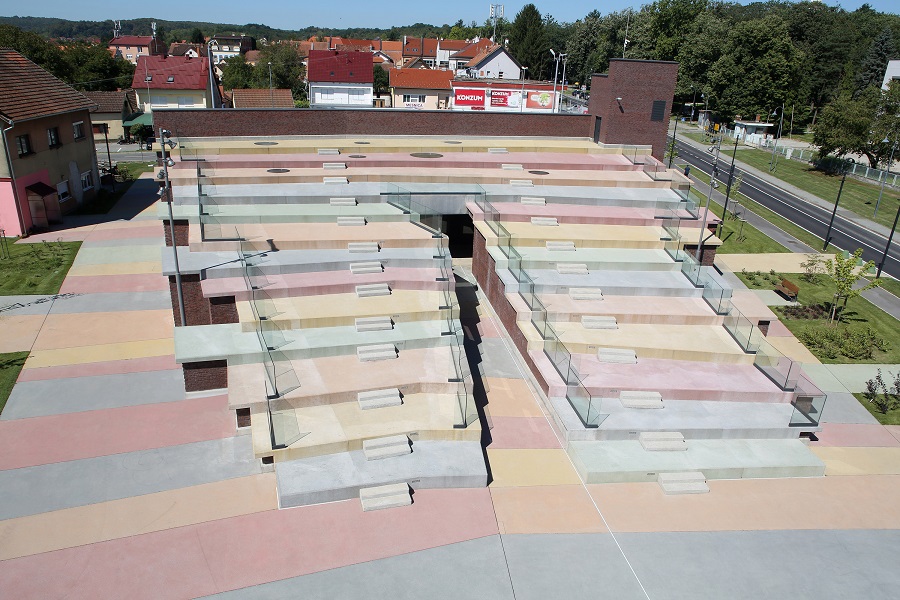
Bećarac Square in the center of Pleternica, under whose stands the Museum of Bećarac will be located, is designed as a reminiscence of golden Slavonian fields and sunny hills / D. Fabijanić, The City of Pleternica
"The Museum of Bećarac will be a presentation of heritage with all modern techniques: music, video, and visual recordings, and at some point, you will even have the feeling that you are running through wheat fields," said Antonija Jozić, the Mayor of Pleternica.
Apart from Slavonia, the Croatian regions of Baranja and Srijem are also home to bećarac, and it belongs to them equally. Furthermore, it is also performed in parts of southern Hungary and Vojvodina. It is a part of traditional culture throughout much of the Pannonian Basin. Like its UNESCO protection, its continued performances seek to preserve a special Slavonian tradition. This dedicated museum will also contribute to doing just that.
"Folk costumes and other objects will be exhibited in the museum, too, because it is very important, but we will use other methods to contextualize these objects. First of all, this is not a museum of folk costumes, but a museum of folk song bećarac. And it is performed. So we have to figure out how bećarac will be in focus all the time, but then we will, of course, talk about other anthropological, ethnographic, and historical phenomena related to bećarac," explained Dragana Lucija Ratković Aydemir, founder and director of Muza company which participated in the presentation of the museum project on January 13, 2020.
The Museum of Bećarac is part of a large project called "Svijet graševine" (The world of graševina), which is being carried out by the City of Pakrac, with the City of Pleternica as one of the partners. Out of the total 65.7 million kuna of the project, 30 million kuna is intended for the Museum of Bećarac, while the rest is intended for the City of Pakrac's "Spahijski podrum" project and branding.
The rich city cultural treasury
The Museum of Bećarac is designed as an extension of the tourist offer of the small Slavonian town. Pleternica has about 11,000 inhabitants, but every year, one event attracts as many as 100,000 pilgrims there. It is the Novena of Our Lady of Tears, whose sanctuary is located in the heart of Pleternica and for which the city of Pleternica is otherwise known. It is held every year from 23 to 31 August.
The June Days of Amateur Creativity called LIDAS are also important for Pleternica, during which the splendor of the cultural treasury of this region is presented. The children's tamburitza festival "Cvjetići glazbe" (Flowers of Music) is held on those days and is the only one of its kind in Croatia. Due to the parish church of Sv. Nicholas, who is the patron saint of the city, Pleternica City Day is celebrated each year on December 6th.
Pleternica has been looking for a "trigger" for a long time to help them attract even more tourists, and they finally recognized it in bećarac.
"Many years ago, at the suggestion of one of my fellow citizens, we protected the name of the Museum of Bećarac at the Intellectual Property Office because we felt that it could be a good story that would bring tourists to Pleternica. As European funds were available to us, we developed the project and, now we are in the phase of completing equipping the museum. I believe that from the end of next year we will be able to count the tourists who will come to Pleternica," the mayor Jozić told Večernji list.
An interpretation center rather than a museum
The museum currently produces all video and audio materials, applications, art installations, and procures all exhibits, and to consistently convey the spirit of Slavonian tradition to visitors, preparations by museologists, experts, and ethnologists are indispensable.
"The museum we are working on is not a classic museum, it is more of an interpretation center, that is, a visitor center. We will show all tourists who come what bećarac is and what Slavonian life is. And then, of course, when they visit the museum, we hope that they will visit all our other beauties, from wine roads and cellars to family farms," says Antonija Jozić.
First Gay Marriage Held in Kutjevo, Heart of Slavonia
November 5, 2020 - The first gay marriage held in Kutjevo was between locals from the area of Čaglin Municipality.
As the city clocks struck midday, two men, locals from the area of Čaglin Municipality said goodbyes to their single selves and embraced their future together as husband and, well, husband. Their affirmations were heard in front of the registrar of Kutjevo and thus, officially, they became partners in a same-sex marriage. It was the first gay marriage to take place in Požega-Slavonia County.
Portal Požega.eu reported that the intimate marriage ceremony of the 47-year-old and his 32-year-old partner took place over recent days, far from the gaze of the public. The ceremony was a quiet and private affair. In rural areas like Požega-Slavonia County, such marriages are not always met with widespread approval. The city registrar reported that this was the first gay marriage they had been asked to witness, despite having been in the job for many years.
Though this may be the first gay marriage to take place in Požega-Slavonia County, hundreds of same-sex marriages have concluded in Croatia since 2014, when the Life Partnership Act came into force. In the time since then, male same-sex marriages in Croatia have been slightly more common than female ones. The largest number of such marriages took place in Zagreb. From published figures outside of Croatia, where same-sex marriages have been more commonplace over a longer period of time, same-sex marriages are frequently more stable with fewer ending in divorce compared to traditional marriages.
Life partnerships in Croatia
The first same-sex marriage in Croatia was concluded in August 2014, and despite the great interest of the public, the two male partners managed to keep the wedding a secret. Just like the couple from Kutjevo. The couple married in the first of the ceremonies in Croatia only went public with details just last year.
"I was very nervous in those days, it was a historic thing after all. If we could not have done it in Croatia, we would certainly move to a country where it was possible," one of the spouses, Ivan Zidarević, told 24sata, adding that society has changed for the better with the change in the law.
Zidarević said he believes that Croats are tolerant of gay couples. Their marriage ceremony in 2014 was witnessed by two registrars, godparents, several friends, but also the then-Minister of State Administration, Arsen Bauk, initiator of the Croatian Life Partnership Act. Bauk gave the couple a symbolic gift – a pair of ties.
According to the Law on Life Partnership of Persons of the Same-Sex, a life partnership is a family community of two same-sex persons concluded by the competent authority (a registrar). The process of concluding a life partnership in Croatia is very simple. It is necessary to report to the registrar, who then checks whether the preconditions for concluding a life partnership have been met and takes a statement on the choice of surname. After that, the time and place of the ceremony are agreed, which, along with the registrar and partners, takes place in the presence of the godparents.
Happiness despite condemnations
At the beginning of this year, the Constitutional Court decided that same-sex couples in Croatia have the right to be foster parents under the same conditions as everyone else. However, the current constitutional definition of marriage in Croatia does not include same-sex families. A change to legally recognise married same-sex partners in this way was this year demanded by the participants of Zagreb Pride, held on September 19, 2020. Pride organisers said that without a change in the recognition, state authorities are still restricting the rights of gay people and making them second class citizens.
In many EU countries, and more so in Zagreb here in Croatia, same-sex marriages are acceptable and almost every day. But, in rural areas such as Požega-Slavonia County, Kutjevo, and other places like these, such marriages are still of great interest and not universally embraced.
Although they live in an environment where they might encounter condemning views, the happy couple from Požega-Slavonia County decided to legalize their relationship. In comments on Facebook, people wished them luck, and one commenter jokingly wrote: "If they didn't make a toast with Graševina, they didn't do anything. Congratulations anyway!"
For the latest travel info, bookmark our main travel info article, which is updated daily.
Read the Croatian Travel Update in your language - now available in 24 languages
The Country's Biggest Export... Croatian Chocolate!?!
November 4, 2020 - Olive groves and vineyards are iconic elements of the vista on the Croatian coast. They appear frequently, as does the international recognition for the wine and olive oil they produce. This makes it all the more surprising to learn that the country's biggest export is, in fact, Croatian chocolate.
On 4 November 2020, 24 Sata reported the surprising statistics about Croatian chocolate. Their sources are agricultural and food product reports from 2018 and 2019, made by the Croatian Chamber of Commerce. They state that Croatian chocolate and cocoa products were at the top of the export rankings. Croatia wine and Croatia olive oil didn't even get a look-in the top five Croatian exports – the next biggest were corn, tobacco products and then fresh and frozen fish. © Alexander Stein
© Alexander Stein
The production of wine and olive oil in Croatia goes back many thousands of years. The industry for making Croatian chocolate is a baby in comparison – Europeans only encountered cacao beans in the 16th century, while exploring and colonising the Americas. Still, the production of Croatian chocolate does have quite a history.
Bajadera by Zagreb's Kraš is one of the most popular boxes of Croatian chocolate to be given as a gift © Kraš
The oldest maker of Croatian chocolate is Zagreb's Kraš. The company's roots lie in three confectioners from the early 20th century. Union is the oldest chocolate manufacturer in south-east Europe (just two years after its foundation in 1911 was awarded the title of supplier to the royal court in Vienna and Budapest), Karolina, a former flour mill which switched to making biscuits and waffles in 1921 and Bizjak, founded in 1923, which made cookies and wafers. These companies, along with a number of smaller Zagreb confectionery manufacturers were merged in 1950 under the name of Kraš, in honor of Josip Kraš, a Croatian union leader and anti-fascist who was killed in World War II. Their range today includes the bars Dorina and Animal Kingdom, boxed classic Bajadera, chocolate biscuits Domaćica and the wafer bars Napolitanke and Tortica. Kandit's classic Rum bar, made in Osijek. Hands-down the best ultra-cheap Croatian chocolate mini-snack bar © Kandit
Kandit's classic Rum bar, made in Osijek. Hands-down the best ultra-cheap Croatian chocolate mini-snack bar © Kandit
The second oldest company making Croatian chocolate is Kandit, which is today still based in Osijek where its parent company was established way back in 1905 as a sugar production outfit. It switched to making waffles, sweets and chocolates in the early 1920s. Its range today includes the kids' favourite Choco Banana and hands-down the best ultra-cheap Croatian chocolate mini-snack bar Rum. It's a classic. Keeping on-trend, the relatively recent No Guilt series of high-quality, no-sugar chocolate bars has made a great addition to Kandit's offer. This range is the only Croatian chocolate currently recommended by the country's diabetic association.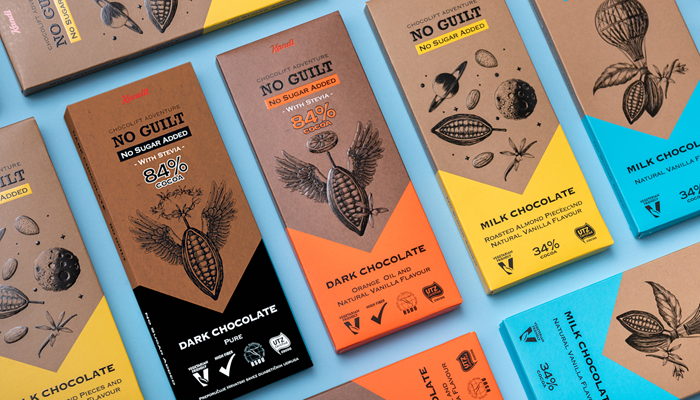 Kandit's No Guilt range has no added sugar and several bars with a high cacao content © Kandit
Kandit's No Guilt range has no added sugar and several bars with a high cacao content © Kandit
The third big player in the Croatian chocolate scene is Zvečevo, from Požega. The company traces its roots back to 1921, but its association with chocolate only really began in 1934 when Swiss company Nestle began to manufacture there (the association continued until 1995). Zvečevo is notable as having invented the combination of toasted rice and milk chocolate in a bar. Now considered a classics pairing across the world, it was first produced in 1964 in Požega under the name of the Mikado bar. As well as still making this classic of Croatian chocolate, Zvečevo now makes a dark chocolate version, chocolate for use in home cooking and a popular range of strong alcoholic drinks. It has won several awards for its ethical and eco-friendly business practices. Zvečevo's Mikado range. With Mikado, the Požega-based manufacturers were the first in the world to combine rice and chocolate © Zvečevo
Zvečevo's Mikado range. With Mikado, the Požega-based manufacturers were the first in the world to combine rice and chocolate © Zvečevo
Standard Croatian chocolate available on the high street can be a surprise to visitors. It has a higher content of the cheaper ingredient (sugar) than the more expensive ingredient (cacao) than many chocolates made in more westerly European countries. But, that's the way Croatians seem to like their chocolate. Well, most of them. According to a survey conducted in 2017 by the Hendal agency and JaTRGOVAC magazine, 63.5% of asked Croatians said they choose domestic chocolate products above the 36.5% who more often buy foreign chocolate products. © Nawal Escape
© Nawal Escape
Data from the Central Bureau of Statistics state that in 2018 the country produced 18,799 tons of Croatian chocolate and cocoa products. Over 800 million kuna's worth of Croatian chocolate was exported in the same year. The bond between Croats and their Croatian chocolate is strong, the love heartfelt. It is no doubt this affection for confection that has prompted some of the third of Croats who go in search of foreign alternatives, for the introduction of premium chocolate ranges by the aforementioned big manufacturers of Croatian chocolate and for the rapid increase in artisan and handmade Croatian chocolatiers over recent years.
Croatian chocolate smaller and artisan producers
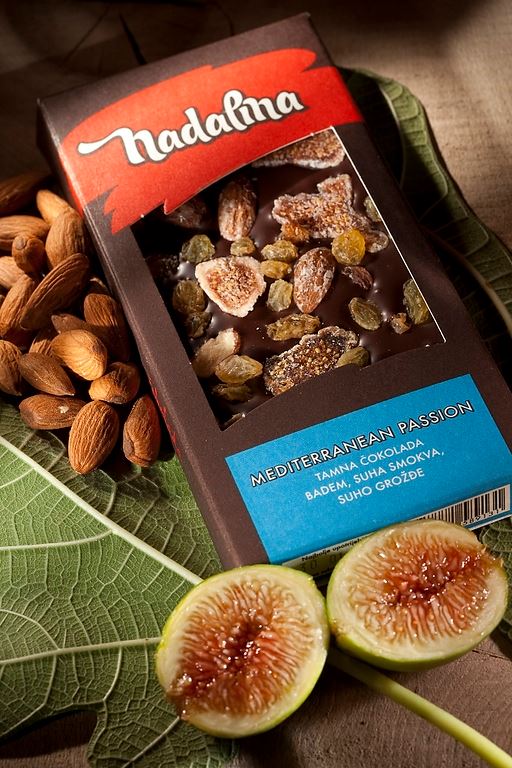
Split-based Nadalina have become increasingly recognised over recent years © Nadalina
Split-based Nadalina make high-quality raw chocolate bars with non-standard flavours like rosemary, figs and olive oil. They held the Guinness World Record for making the world’s largest chocolate bar and in 2017 were voted the world's third-best at the International Chocolate Awards. Vilma slastice from the island of Rab combine dark chocolate with flavours like Pag cheese, white truffles and lavender. Salt manufacturers Solana Nin have a salt-infused chocolate and Zagreb's Chozen make impossibly-pretty handmade Croatian chocolate pralines with a surprising and adventurous range of flavours. Besides these, the list of small manufacturers of Croatian chocolate grows every year. It seems that the love affair between Croats and their chocolate is far from finished, and that's certainly good news for Croatian exports.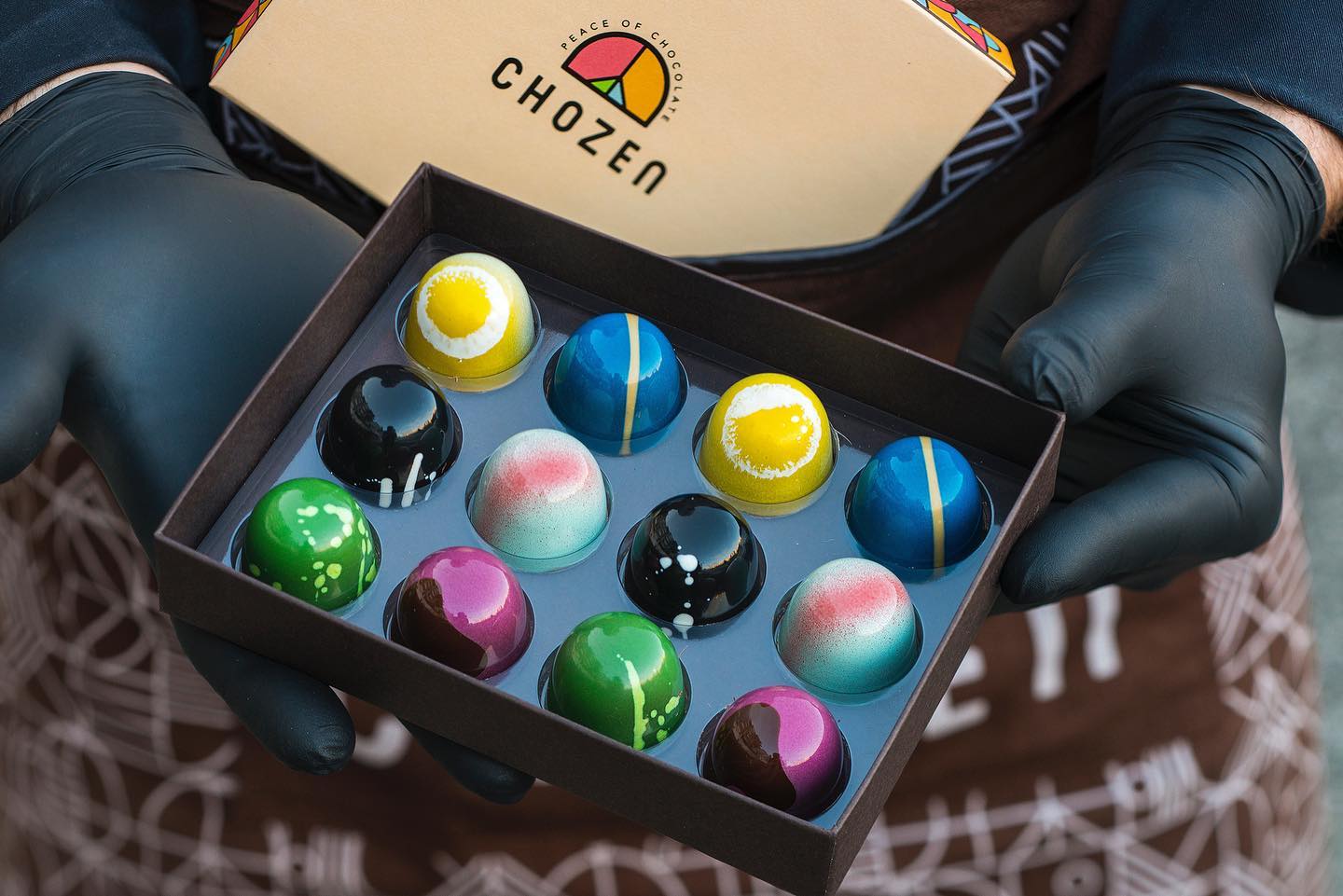 Impossibly pretty handmade chocolate truffles, produced in Zagreb by Chozen © Chozen
Impossibly pretty handmade chocolate truffles, produced in Zagreb by Chozen © Chozen
For the latest travel info, bookmark our main travel info article, which is updated daily.
Read the Croatian Travel Update in your language - now available in 24 languages
Meet HGSS The Croatian Mountain Rescue Service
August 19, 2020 – All weather, all terrain, all year round – meet HGSS The Croatian Mountain Rescue Service, amazing volunteers who will never let you down
They're never far from the news. For the last two weeks, members of HGSS The Croatian Mountain Rescue Service have yet again been on the TV news every night. They're leading the search for a summertime visitor, a Polish hiker missing on Biokovo mountain.
But, watch again this winter and, for sure, they'll be in the headlines once more. Whether, they're scaling mountain ranges in the unbearable heat of high summer, searching underwater caves, flooded rivers or the sea, breaking through wild forest or trudging through metres of snow, they undertake their search and rescue missions over every terrain, in every weather condition, in every month of the year, all across Croatia. And, they all volunteers.
Marc Rowlands meets the head of service for HGSS The Croatian Mountain Rescue Service and three of its volunteers to find out who they are and what makes them do what they do.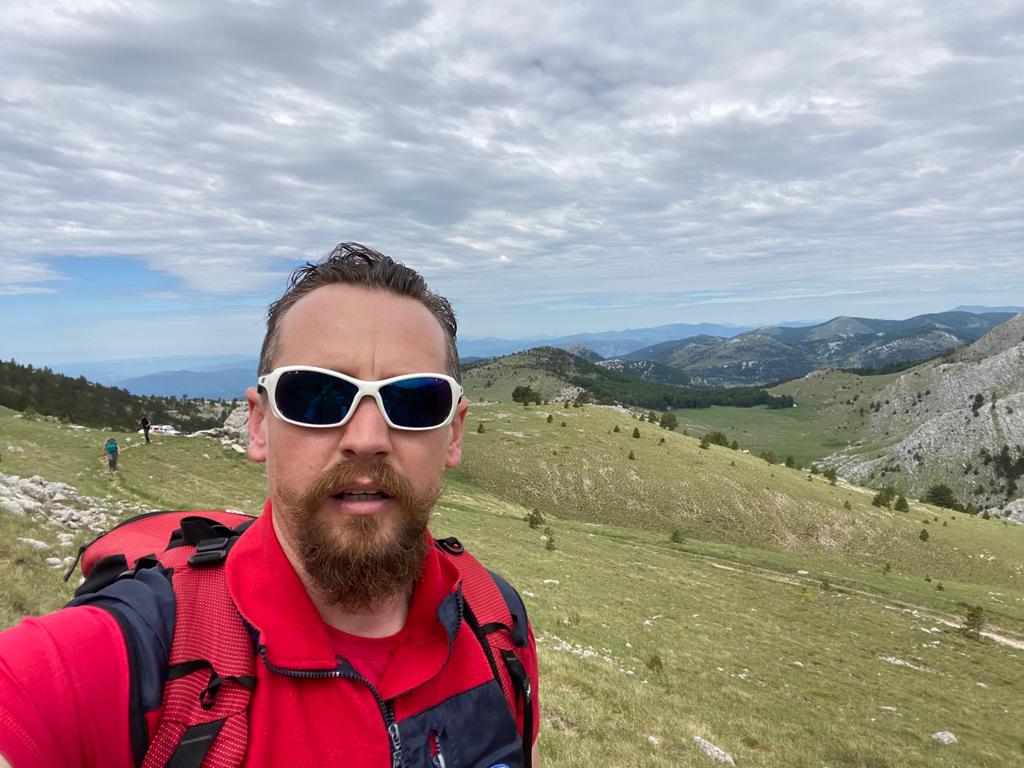
Josip Granić, head of service for HGSS The Croatian Mountain Rescue Service
My name is Josip Granić. I'm the Head Of Service for HGSS The Croatian Mountain Rescue Service. We've had an extremely busy couple of weeks. Being head of service for an organisation like this under such circumstances means you're always on the phone; co-ordinating, talking to outside organisations, members of the press. Communication. It's a 24/7 job, 365 days a year. If people need help, you can't take a holiday. Not at this level of the organisation.
We have around 1000 members. There are 11 paid positions in the main organisation and 25 people we pay to run the administration in each of the teams or stations we have. All of the members who perform the search and rescue are volunteers. We have pilots, surgeons, nurses, students, professors, every part of society.
I'm originally from Kaštela, but my home station is in Karlovac. I've been there for 15 years. I've been Head Of Service for two. Since I assumed the position, I've spent most of my time in the car. I travel all over Croatia.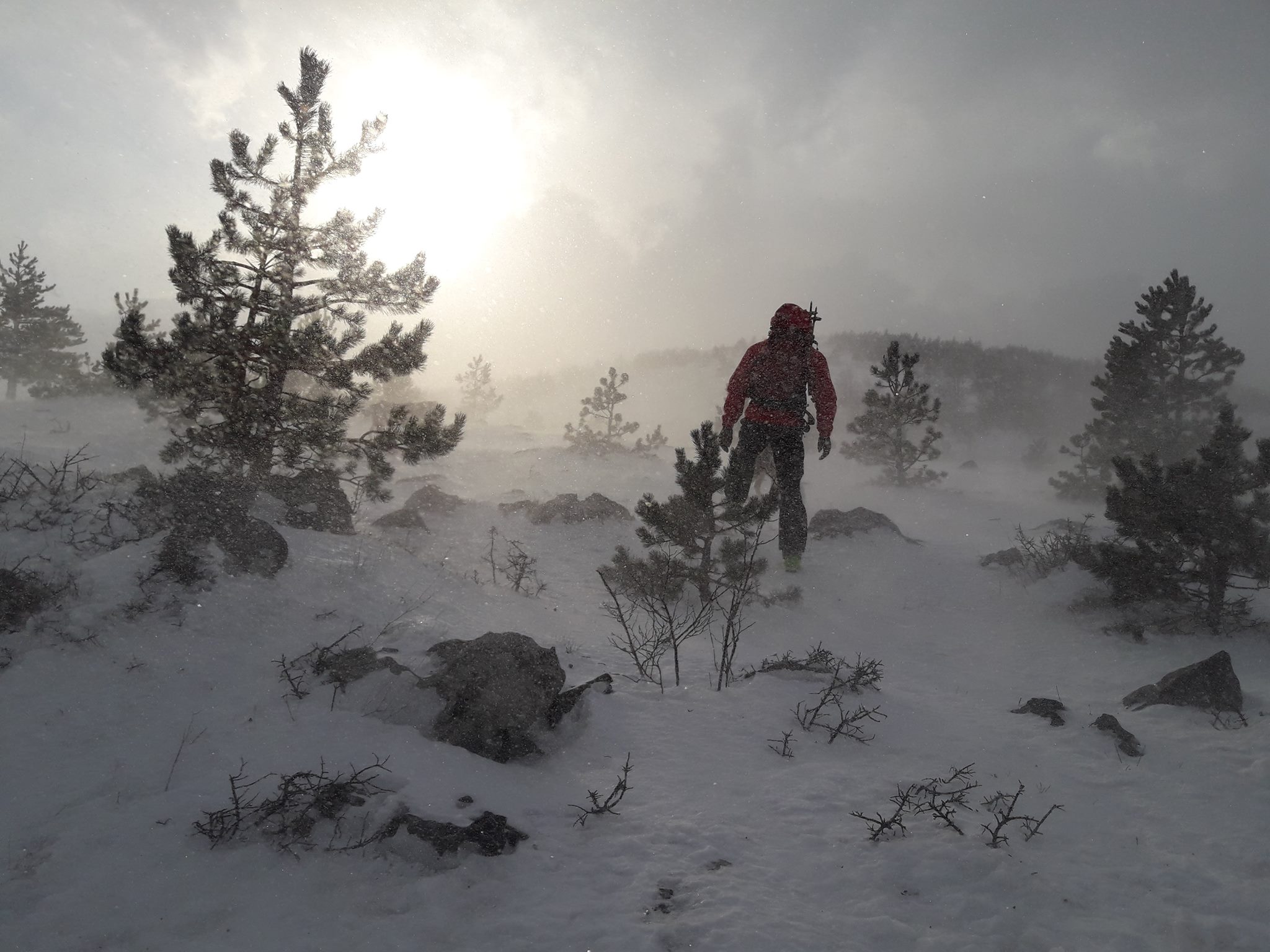
HGSS The Croatian Mountain Rescue Service missions can be hampered by extreme weather conditions © HGSS The Croatian Mountain Rescue Service
To get a certified position as a mountain rescuer in Croatia you all do the same training. It doesn't matter if you come from Slavonia, Dalmatia or Istria, you must have the knowledge and ability to deal with circumstances in any terrain; caves, pits, mountains, on snow, underwater.
Depending on where your station is, the type of call-outs you get could be very different. In Slavonia, 90% are for missing persons - searching forests, rivers, and in floods. We've had a big search on Biokovo mountain for the past 16 days. The stations from Split, Makarska, and Dubrovnik were at first involved, then teams from all over Croatia. It's not the same as Slavonia. The terrain is very different, so you have to be good at a particular set of skills. But, the largest percentage of call-outs is still missing persons. It's 70% of our work nationwide. The other 30% are rescues.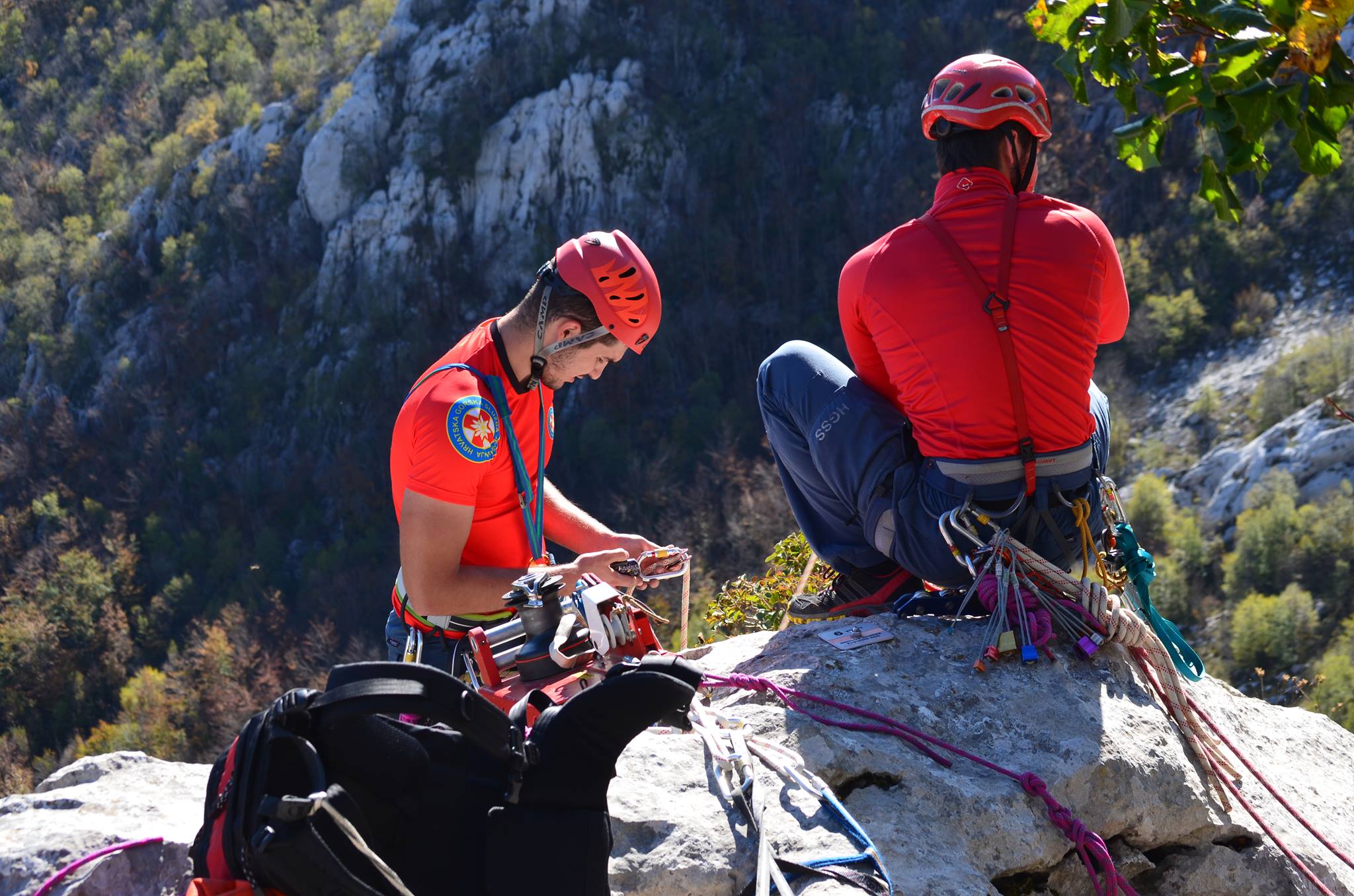
HGSS volunteers are educated to use a wide range of technical equipment. They are trained to operate in all the different kinds of terrain found across Croatia © HGSS The Croatian Mountain Rescue Service
There are usually 800 – 1000 missions a year across the country. We get roughly the same amount of calls in colder months as in warmer months. Only, winter months can be busier. The terrain is more difficult. There are some villages in Croatia – usually where the front line of the fighting was, around Karlovac, Kordun, Lika – and when it snows, it can be almost impossible to reach those places. But, some older people still live there. It can take days to reach them on snowmobiles, then skis, to deliver food or medecine. The other busiest places in winter are the ski resorts - Platak, behind Rijeka, and in Zagreb, on Sljeme. There are teams stationed in those places throughout the snow season.
What's the greatest danger of the job? Almost everything. Nothing in this job is easy. The greatest dangers we face are the same facing those that we rescue - underestimating the environment, nature, the conditions. That's where our training comes in.
In mountain rescue, we separate dangers into subjective, objective and technical. Subjective is the stuff you're guilty of - lack of preparedness, knowledge or equipment. Objective dangers are the ones you can't control, like sudden changes in weather, or avalanche. If you're sensible and informed, there should be no objective danger.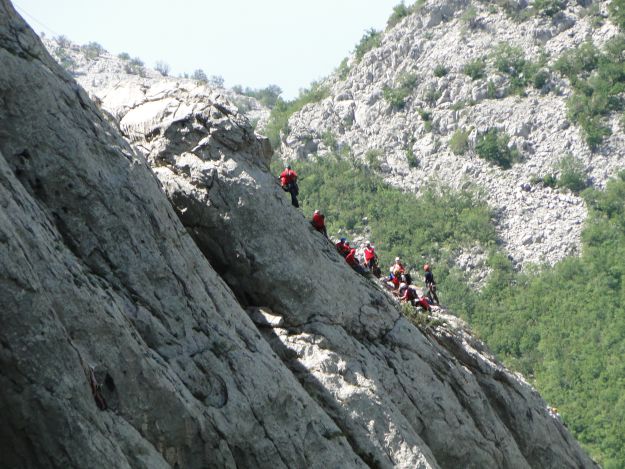
HGSS on a mission, clinging to a steep incline in Paklenica © HGSS The Croatian Mountain Rescue Service "People need to be aware at all times on the mountains. By the time most people think they may be in trouble, they've usually been in trouble for five or ten minutes already" Josip Granić.
80 – 85% of the people we rescue are Croatian. Only 15 – 20% are guests. People from Czech Republic, Slovakia, Poland, (Austria and Slovenia too) tend to enjoy nature more. They like hiking. That's the reason there are typically more rescues for those nationalities than there are for British, Belgian, French, Italian, America, Canadian or Australian guests. I don't remember the specific year, but sometime between 15 and 20 years ago we had a season where 5 or 6 Czech nationals were being searched for or, sadly, turned up dead. The media covered it and ever since there's been this myth that all the people who get into difficulty are Czech.
The question about expensive helicopter rides - why don't you charge the people you rescue - has been here forever. It's like this - if you're a tourist and you have a car accident in Croatia, the fire service, police and an ambulance will come. You won't get charged. We are a tourist country. According to international agreements, we are obliged to make everything safe for residents and guests alike. We are here, just like the fire service and police, to do our part. The Croatian air force is responsible for the helicopter rides and I have to give credit to them - they are crazy good pilots. Amazing. Even if we did charge everyone we saved - and most of the 85% of Croatians we save would struggle to pay - it still wouldn't be anywhere near the money required to run this service.
The Croatian Mountain Rescue Service used specially trained dogs on their searches © HGSS The Croatian Mountain Rescue Service
In 2007, I got a new search dog. It came from the Ogwen Valley Mountain Rescue service in North Wales. We cooperate a lot. We were sent out on a job to look for a three-year-old male child who had gone missing near Požega at the beginning of January, wintertime. His grandma was watching him and they were in a house on the edge of the woods. Early in the morning, he was playing with a dog. It suddenly ran into the forest and the boy chased after him. The grandmother didn't see it happen. I found him using my new dog, just after 8 o'clock the next morning. He'd been alone in the freezing forest for almost 20 hours.
Time is really moving fast on a job like that, because it's a kid and because it's so cold. Survival rates in such conditions are not good after 24 hours. When I found him, saw that he was alive, those big eyes looking up at me, it's a crazy feeling. You can't describe it. You can't compare it. A lot of positive emotions.
Every mission is special. We meet them all with the same level of determination and professionalism. But, it's the ones where you know you've really saved someone that stand out in the memory. Not the broken leg, where you transported someone – sure, that's an excellent job. But, when you know you've saved someone's life, that they definitely wouldn't be here now if it weren't for you, that's what makes it all worthwhile.
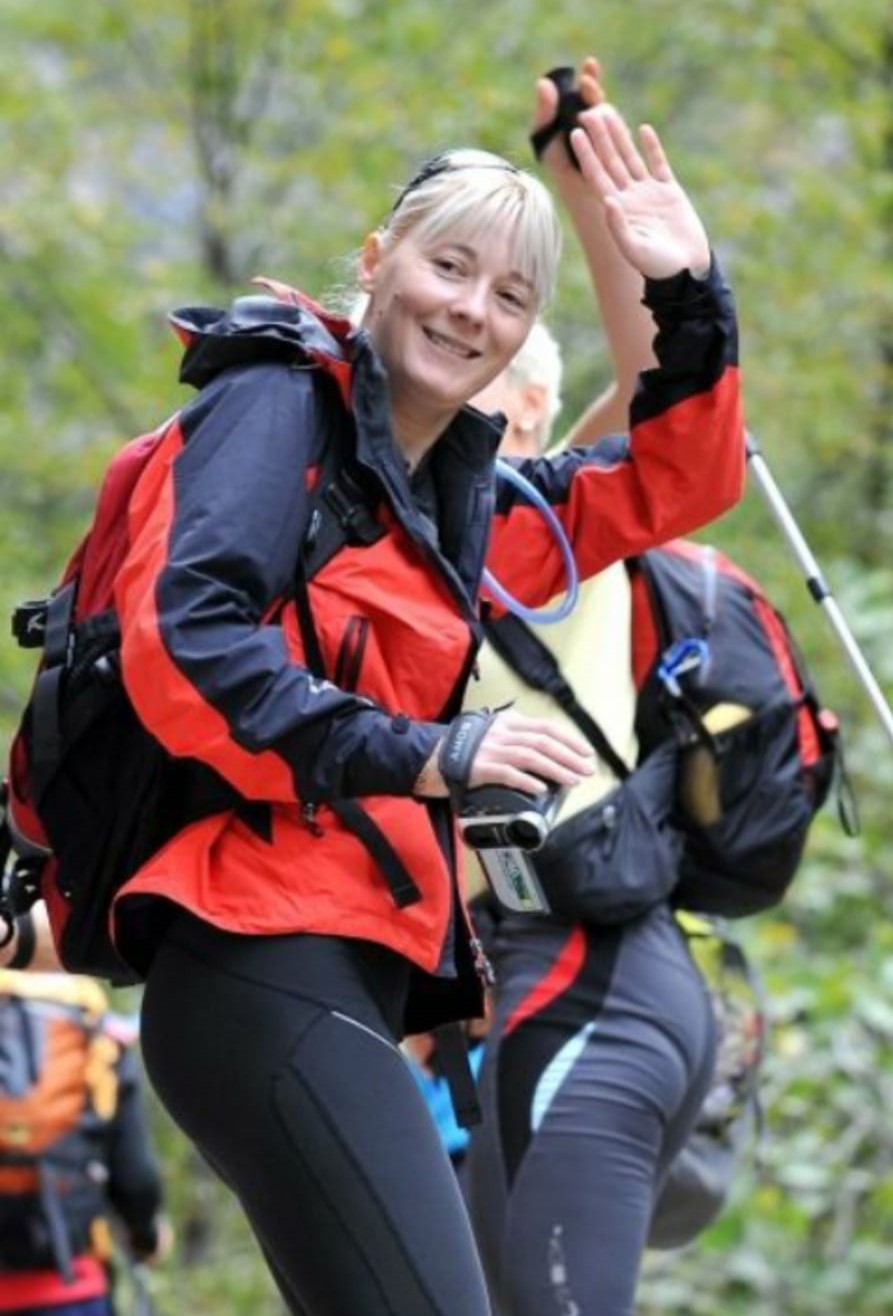
Jana Mijailović, volunteer for HGSS The Croatian Mountain Rescue Service
My name is Jana Mijailović, I'm 48 years old and I'm from Zadar. I finished school to be a teacher, but I never did it. My husband and I run a company that does plastic and aluminium windows for houses.
I started to go into the mountains when I was at high school. I never had the ambition to be part of mountain rescue services – people just noticed me on the mountains. They said I'd be good at it and asked me to join. I met my husband on the mountains. We are both volunteers for HGSS The Croatian Mountain Rescue Service. I've been doing it for 16 years.
I was a member of the first and second all-female Croatian expeditions to the Himalayas. We first climbed Cho Oyu in 2007, then Mount Everest in 2009. Croatia is the only country in the world that has only one successful male climber of Mount Everest, but four successful female climbers. I sometimes work as a guide too. I guess you could say I'm all about the mountains.
Being a climber, an Alpinist, I know that if I get into trouble, it's only my HGSS colleagues who can help. I feel this instinctively. I cannot be in the house, safe and warm, knowing that maybe someone needs help that only I can provide.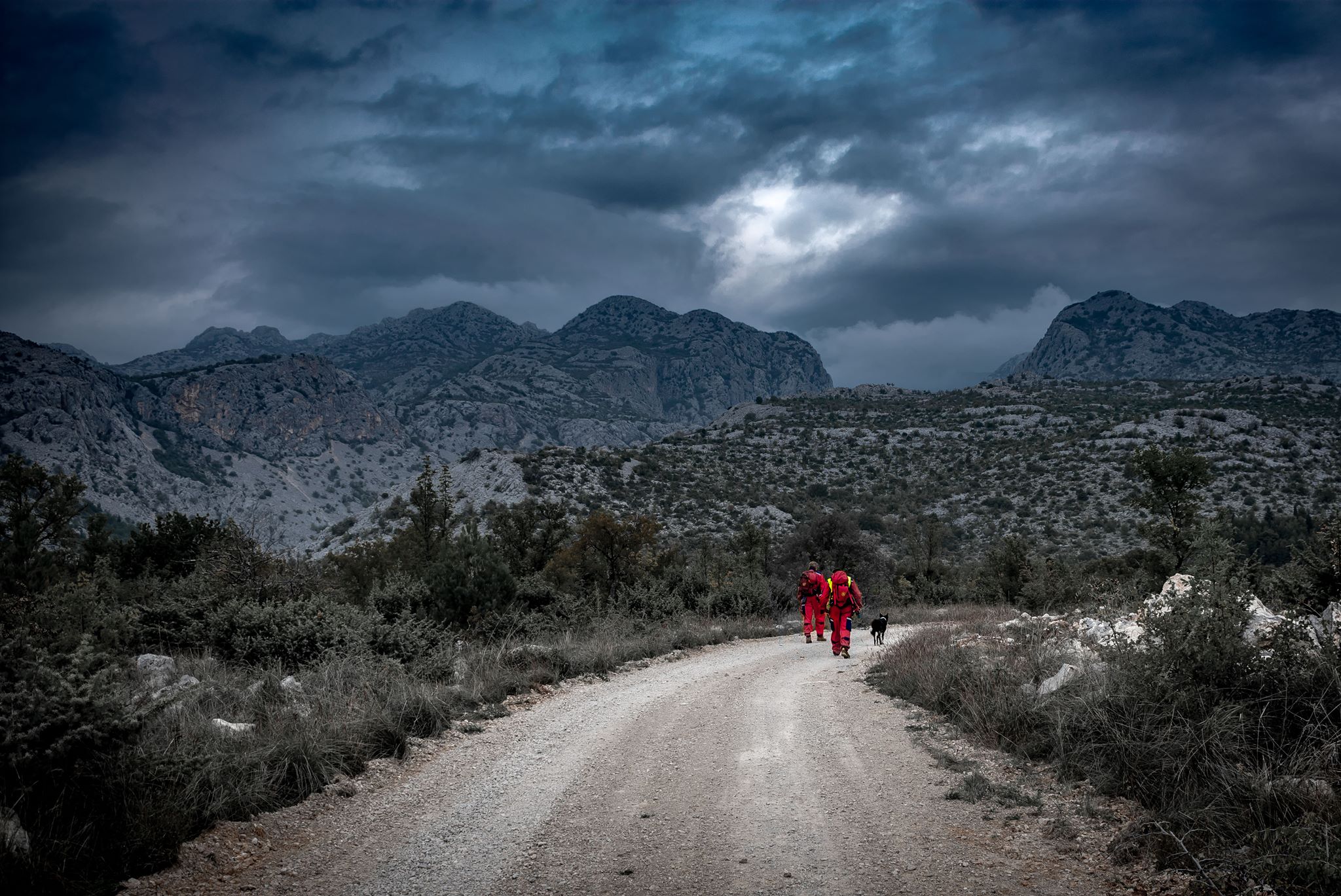
HGSS The Croatian Mountain Rescue Service members entering Paklenica under foreboding skies © HGSS The Croatian Mountain Rescue Service
I've really been on so many expeditions with HGSS. My station are on duty in the season at National Park Paklenica and I'm now the coordinator. Climbers from all around the world come and so there are many interventions. None of them are easy because the terrain is incredibly difficult. You really have to be in shape and know the techniques inside out.
I'm very proud of my statistics. Everyone I've rescued, who was alive when I reached them, is still living today. Unfortunately, not everyone we reach is alive when we arrive.
I remember one time, my husband and I were having dinner. We were arguing about the techniques and knots for moving a stretcher down a vertical climb. The training is so intense, you really have to know it well, and I guess that's just the kind of people that we are, that we would be arguing about it in our free time. Ha! He told me, "Why do you care? You'll never have to do that," because usually, it's really strong guys who do that specific job. If you're on a 400-metre-high section of rock, it really takes a lot of muscle.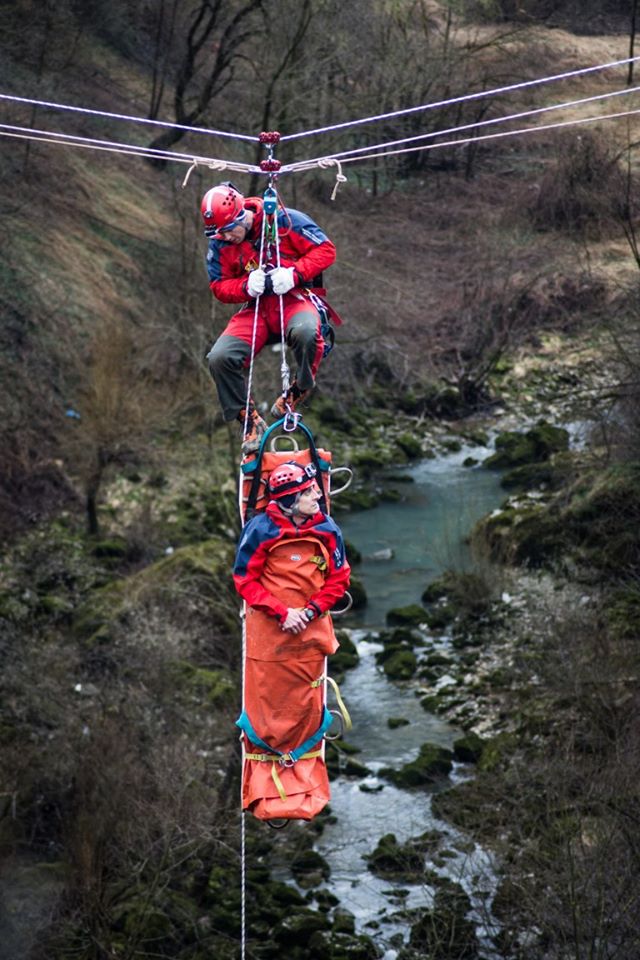
Ascending from a valley floor or descending from a mountain peak with a stretcher is a technically difficult operation, often hindered by darkness and adverse weather conditions. It requires a lot of training and a lot of muscle © HGSS The Croatian Mountain Rescue Service
In the evening, just two days later, we were called out to rescue an Italian guy who broke his leg on Anića Kuk. It's a really mighty part of the stone. And the leader of the expedition asked me to go on the stretcher. They pull you down on the ropes and you have to push very hard to keep the stretcher, the person you're carrying and yourself away from the rock, while balancing the weight of all three. It was dark, raining and with lots of Bura, the incredibly strong wind that sometimes hits us. That's probably my most memorable rescue.
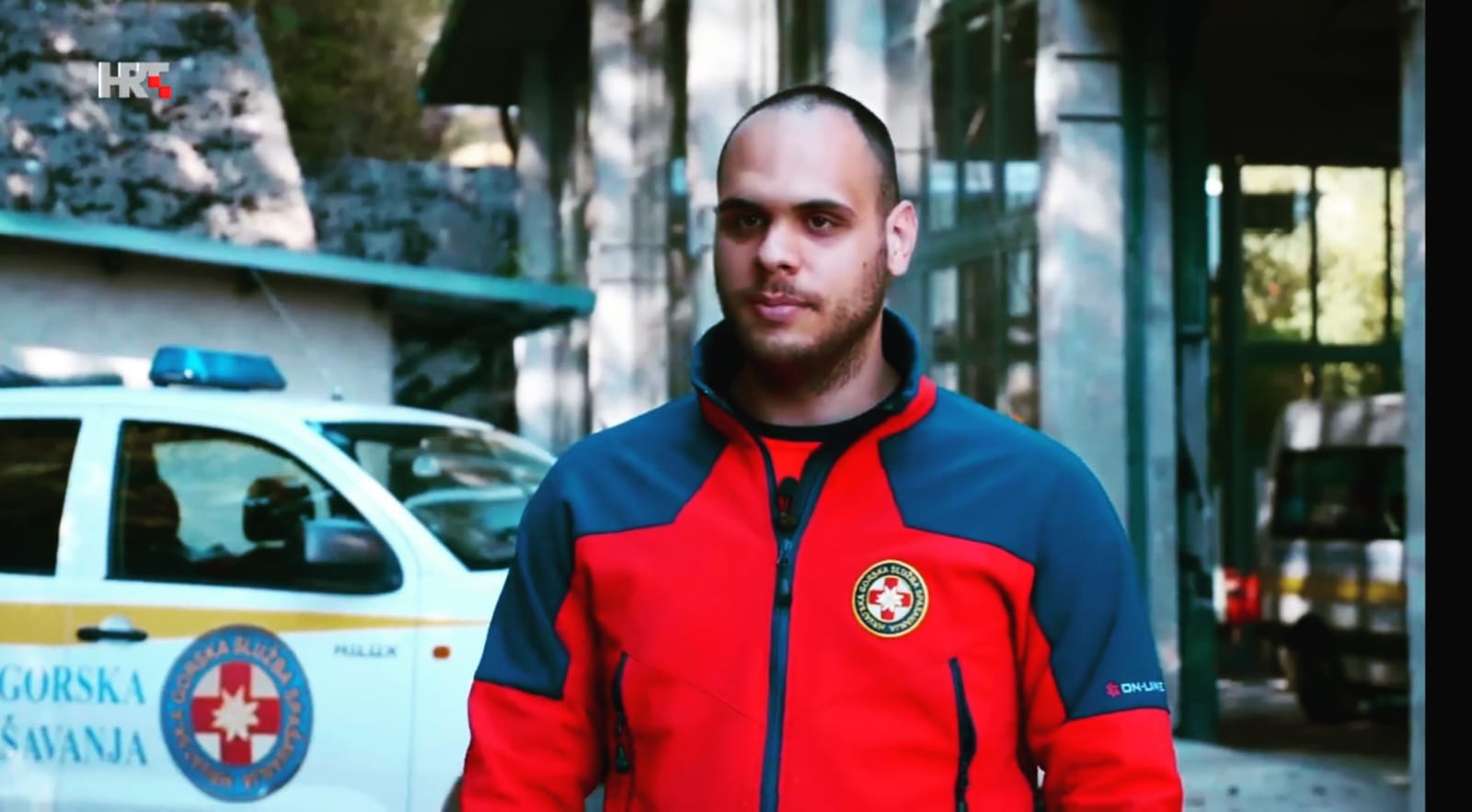
Petar Prpić, firefighter and volunteer for HGSS The Croatian Mountain Rescue Service
My name is Petar Prpić, I'm 25 years old and I'm from Hrvatska Kostajnica, just on the Croatian-Bosnian border. My station is in Novska. In my full-time job I'm a professional firefighter. I guess I have two dangerous jobs. Well, one job and one hobby.
I've always been interested in the outdoors – mountaineering, hiking, canoeing. But, that's not why I joined HGSS The Croatian Mountain Rescue Service. I just wanted to help people. I don't know, I guess it's just something in me.
We have a lot of rivers in our area. During the times of flood, we get a lot of call-outs. Our part of the country has a high percentage of elderly people in the population. A lot of them live in small villages, on the edge of the forest. We get a lot of call-outs for searches. Especially in the autumn when people go out looking for chestnuts or mushrooms. But, like all the stations in Croatia, we are here year-round if there are any actions in other parts of the country that need us.
In some areas, HGSS The Croatian Mountain Rescue Service are frequently called out in response to flooding. This picture shows HGSS members on operation during the 2014 floods. In that year, flooding across the whole region was so bad that HGSS members operated not only in Croatia, but also donated their services to neighbouring Bosnia and Serbia © HGSS The Croatian Mountain Rescue Service
I was just on the search in Biokovo. The head of service called me and asked me to go. I first had to get some free days from my job. I called my boss, Zvonimir Ljubičić, chief of the fire department. He's great, very understanding, and he gave me permission. Two years ago I was called to Rab. Very hard operation, very difficult terrain.
Late last summer, we were called out to look for an older man near Glina. It was around 11 o'clock in the evening. He'd gone to look for mushrooms in the afternoon and never came back. Police were there and they sent for us.
The man had a cell phone on him, but there was no signal. There was no location given off the phone. We were a team of four, split into two teams. We went up into the woods above Glina and concentrated our search on areas where we could see there was no telephone signal on our phones. We were yelling in the dark. After an hour of search, someone answered. He'd been missing since 2pm. We found him at 2am. He was just lying there, uninjured but unwell, unable to move.
The reason it sticks in my mind is that the next day, in the morning, his daughter called me. She was so thankful, so emotional. For sure we saved his life. None of the other emergency services who were present could find him. It was down to us. We finished the operation at about 6am and then all four of us had to go immediately to our regular jobs.
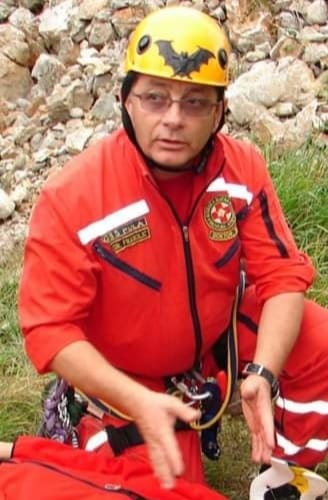
Mario Franolić, physician, ex-commando and volunteer for HGSS The Croatian Mountain Rescue Service
My name is Mario Franolić and I'm 60 years old. I'm the chief of the mountain rescue service in Istria. I travel throughout Croatia because I'm also an instructor for the medical commission of HGSS. I was born on island Krk. I'm based in Pula although I work in Rijeka. I travel a lot between the two. I've been with HGSS The Croatian Mountain Rescue Service for 18 years.
In my day job, I'm a physician. I am a senior mentor at the Institute for Underwater and Hyperbaric Medecine in the Clinical Hospital Rijeka. I'm an expert in my field of emergency medecine. I've been doing it for almost 30 years.
When I was young, I trained to be a physician in Belgrade. It was then the best medical faculty in Yugoslavia. At the same time, I also started spelunking (cave exploration). I've been doing it since 1978. Later, I was a physician in the military underwater commando unit. I lived in Austria for five years, but when I came to Pula, they were just starting the HGSS The Croatian Mountain Rescue Service station here. They asked me for help because they didn't have any medical professional on the team. I accepted. It would be a waste not to use all these skills I have.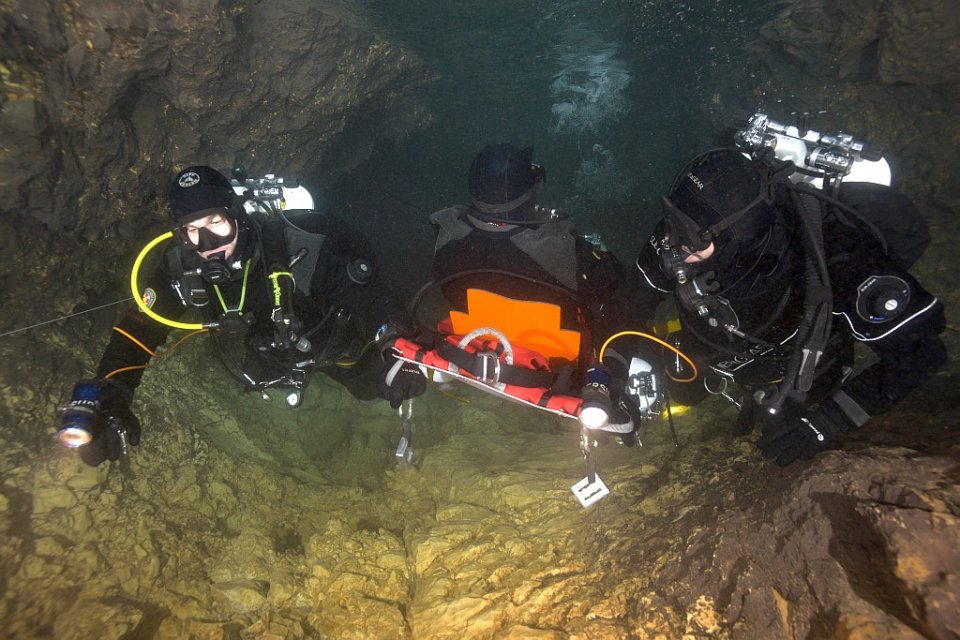
Specialist teams from HGSS are trained in underwater rescue from caves. Such caves exist all over Croatia in the karst rock, and also on some islands © HGSS The Croatian Mountain Rescue Service
Sometimes, our status as volunteers can give us problems. Although we have official duties, we are more like an NGO than something like the police. There can be legal implications. I remember one situation, very acute because a paraglider fell from the sky. None of his colleagues saw him fall. Paragliders go into the air together, but then they each branch off to do their own thing.
We had no idea about the location. We started from the last point of sighting, knowing that it could be very far from the place where he actually fell. But, we had to start somewhere. We had one mobile phone signal direction. But, you need three in order to locate someone. We only had a line on the map.
In the past, HGSS The Croatian Mountain Rescue Service sometimes had difficulties because the telephone companies wouldn't give us the information we needed in order to triangulate the position of a missing person. They would only give it to the police. But, it's a race against time. We searched for this man all day and all night. In the morning, some Croatian paragliders made private contact with a guy from the phone company. They begged him to release the information we needed. Although he could lose his job, giving such information to private citizens, he did it.
We found the man about 150 metres from where we were. Sadly, he was already dead. It was very small comfort to see that he had died instantly, on impact. It's unbearable when you reach someone you could have saved if only you had got there quicker, especially in an instance such as this, where we were hindered by a lack of information that was available. I think it moves more quickly now, but still we have to go through the police.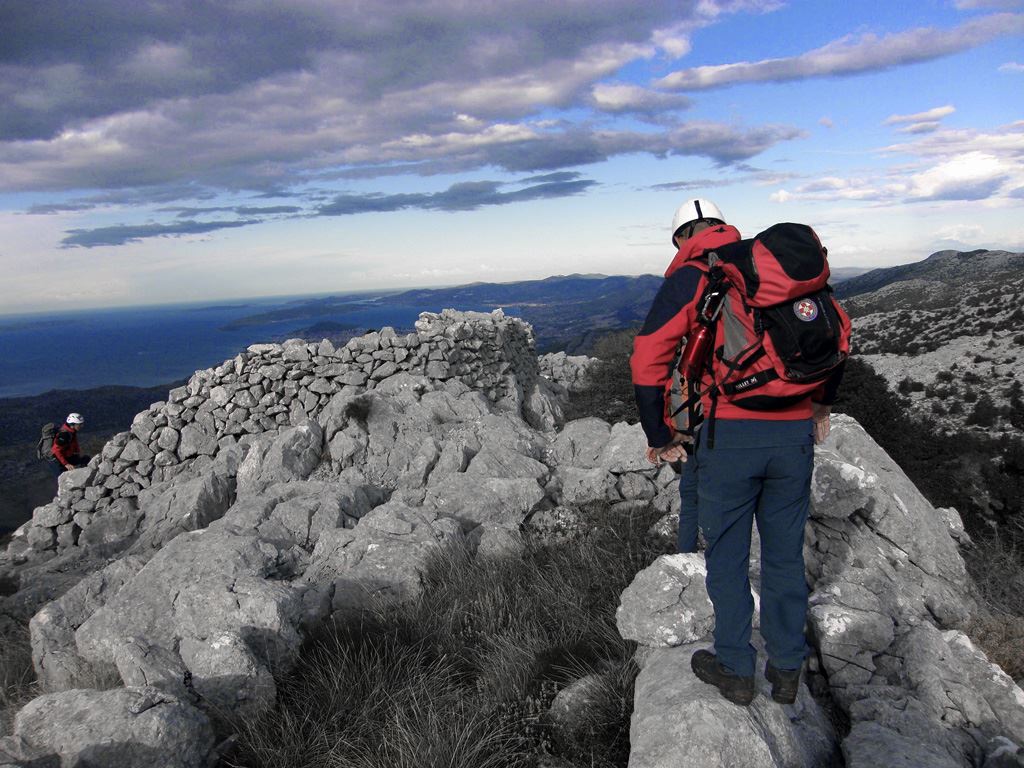
© HGSS The Croatian Mountain Rescue Service
One of the most emotional operations I went on was around five years ago, the rescue of a young girl - maybe two and a half to three years old – who got lost in the woods in a small place in central Istria. She chased into the forest after some dogs around 10 or 11 in the morning. The family saw immediately that she had disappeared and started to search. About two hours later, we were called out. It was impossible for the family to find her.
About 300 people came – my station, the Rijeka station, hunters, firemen, police and volunteers. In such an operation, the police are the lead service. But, 99% of the time they leave the organisation of the search to HGSS The Croatian Mountain Rescue Service. We are the only organisation who is very well educated in organising searches. When other people do searches, they use intuition. But, people all have different intuition. It can be chaotic. We are highly trained for this. There are procedures, recognised internationally, that we follow. We found her early in the morning, at around 7 o'clock. The dogs were lying on each side of her, giving her warmth.
All photos courtesy volunteers and HGSS The Croatian Mountain Rescue Service
Wife-Beating County Prefect to Be Expelled from HDZ?
The long overdue decision finally made?
Young Couple Opens First Hotel in Požega-Slavonia County
People around them did not think it was such a good idea, but they were determined to succeed.


